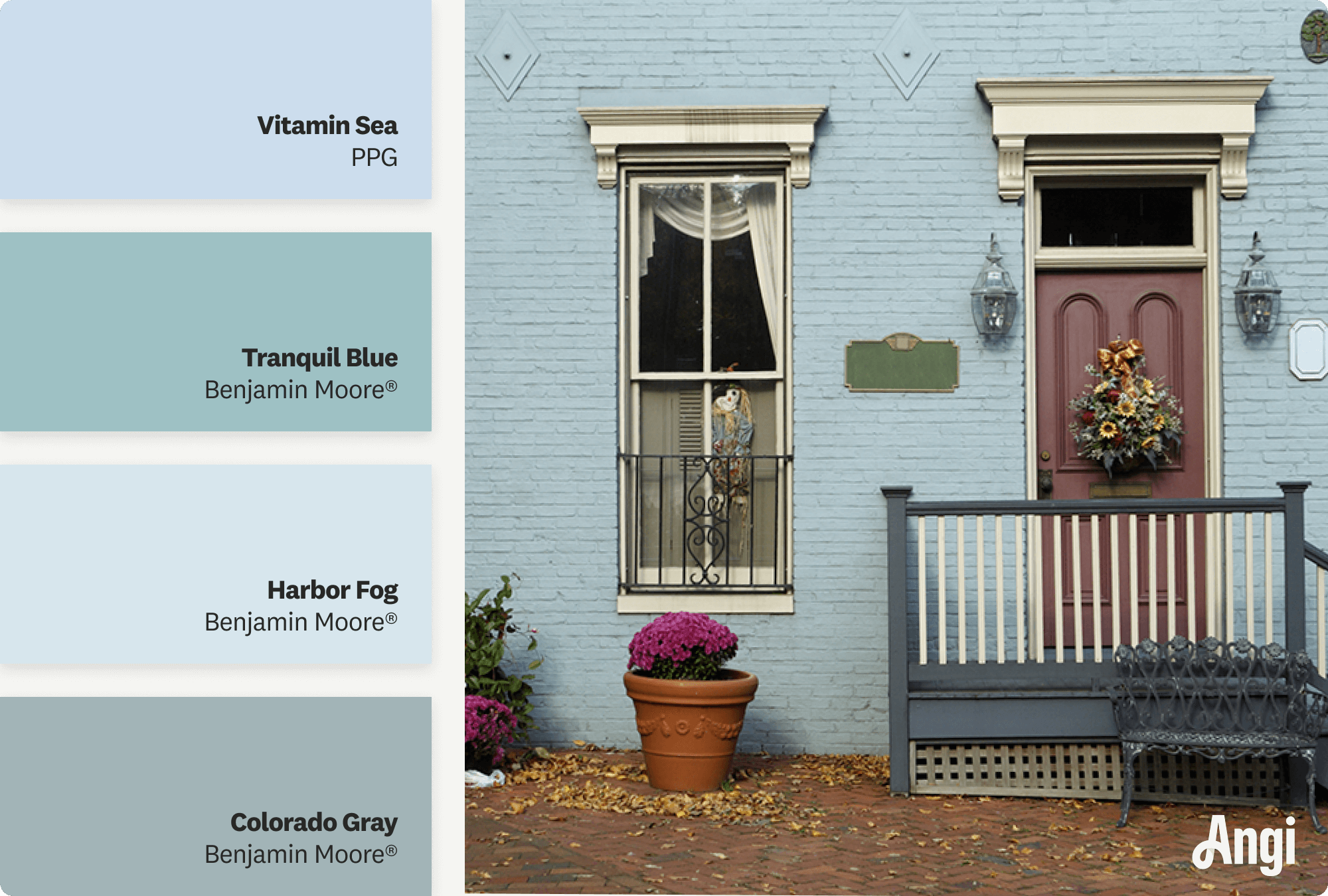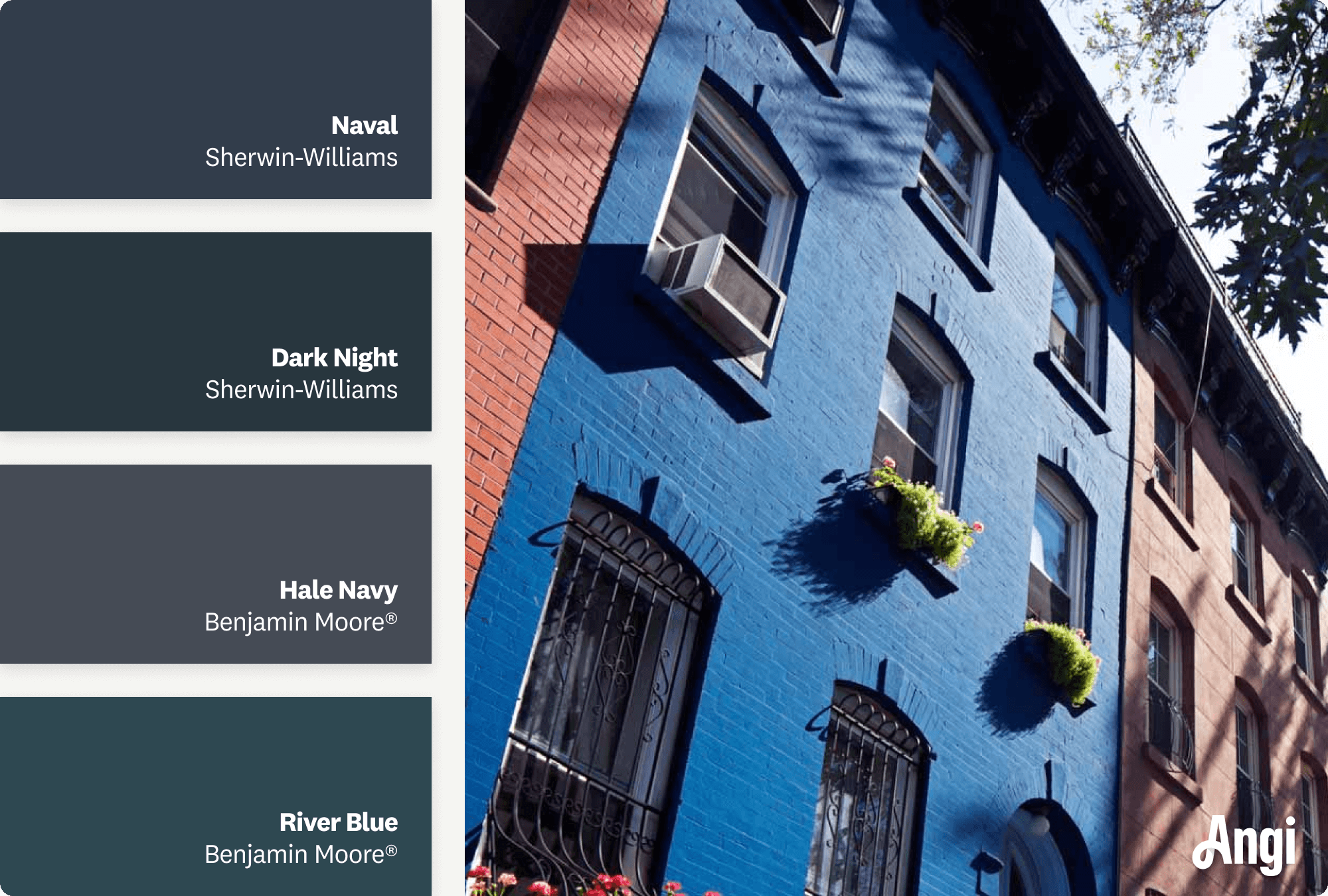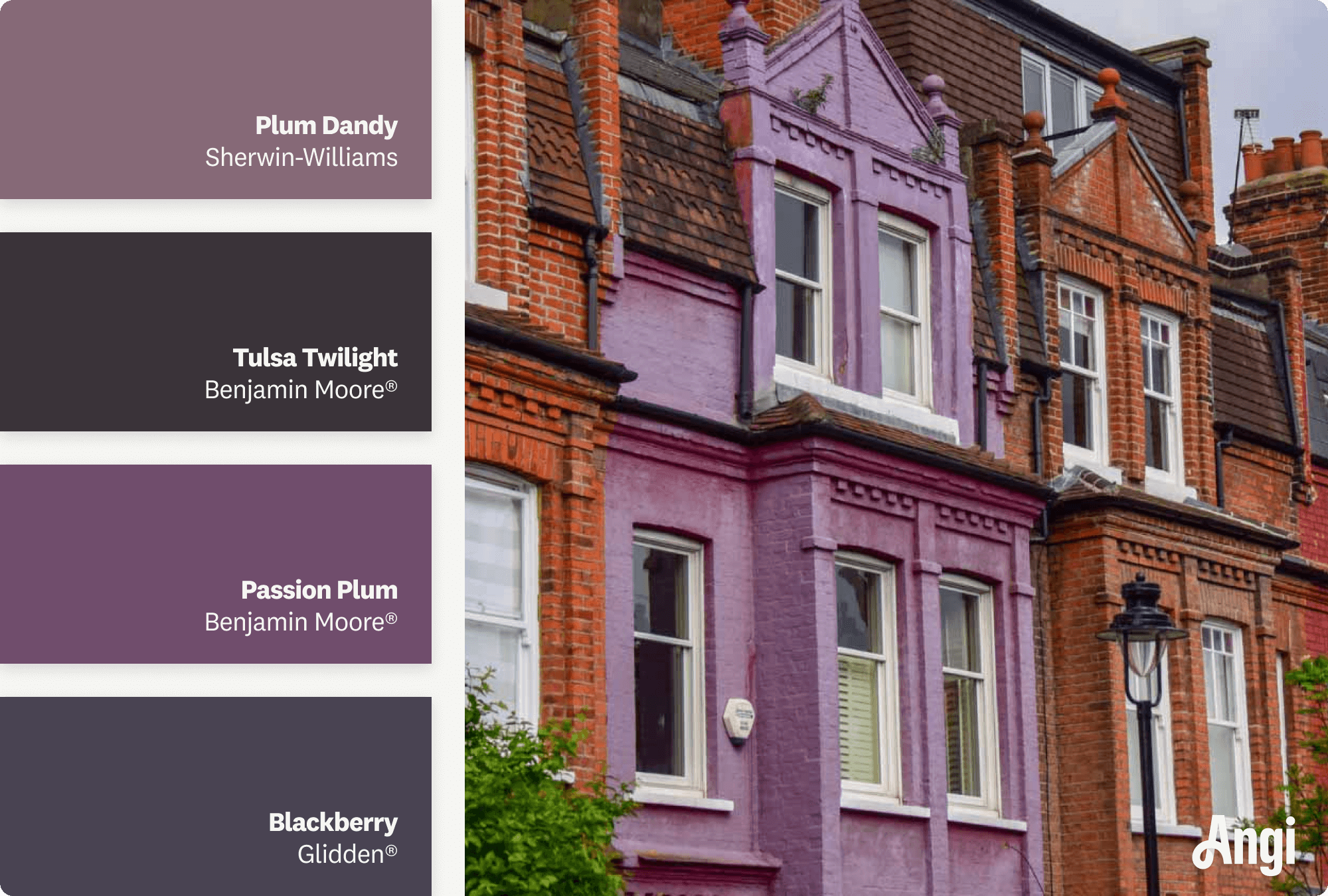
The cost to paint a pool deck depends on the dimensions and material, the type of paint, and whether you DIY. Read on to help determine a project budget.
Natural red brick can look new and fresh when paired with the right paint color


Natural brick homes come with a dominant color built-in. However, most brick houses still have doors, soffits, trim, and possibly siding that will eventually need a fresh coat of paint to maintain the home's curb appeal. This means you'll need to find the best exterior brick and paint color combinations that will complement each other without taking away from one another’s charm. So what color should you paint a brick house?
To help you decide, we've put together a list of the best color schemes for brick houses. Some of these colors work with brick as an accent, while others are more neutral. Some complement red brick, and others pull from the brick. Find your favorite or work with an exterior painter near you to narrow down the best paint color for your brick home.

The pairing of black and brick is timeless and modern all at once. Darker colors like black offer high contrast with any brick color, helping to emphasize a home's details for a sharp, crisp look. Black and brick are a sophisticated and classic combination for any home style. Shades of black range from deep and pure to light velvet tones, some of which are borderline navy or purple.
For inspiration:
Sherwin-Williams Tricorn Black
Benjamin Moore® Onyx
Benjamin Moore® Raccoon Fur
Benjamin Moore® Soot

White trim is a popular choice for exteriors that's always in style. However, a clean, cool white can look too harsh against a red brick exterior. Instead, go for warm, creamy off-white colors. These neutral shades wouldn't be mistaken for white if used indoors, but outdoors they coordinate beautifully with the earthy tones of red brick.
Try creamy whites on doors, columns, trim, shutters, and other architectural accents.
For inspiration:
Benjamin Moore® Swiss Coffee
Sherwin-Williams Westhighland White
Sherwin-Williams Creamy
Benjamin Moore® White Dove

Greige is all the rage, and it's likely not going anywhere soon. This understated neutral combination of gray and beige pairs well with brick's warm, earthy tones. One great way to use greige is to find a shade that matches the grout color between your bricks. Greige trim can provide a muted look that helps brick stand out and play the focal point in your home's façade.
For inspiration:
Sherwin-Williams Gateway Gray
Sherwin-Williams Keystone Gray
Sherwin-Williams Mindful Gray
Sherwin-Williams Functional Gray

Red and green are complementary colors that can balance each other visually. However, you need to be careful when pairing red brick and paint in any shade of green since many shades can clash and end up looking like a Christmas decoration.
To avoid this and bring out the color of the brick without overwhelming it, try a very toned-down, muted shade of green like sage on sidings, shutters, or entry doors. Sage can range from delicate, beige-like shades to muddy, earthy tones, any of which pair well with the natural tones found in red brick.
For inspiration:
BEHR® Simply Sage
Sherwin-Williams Svelte Sage
Clare All The Sage
Dunn-Edwards Wishing Well

Speaking of complementary colors, blue is another nice coordinating color for a red brick home. You can use blue in different ways. Light, airy shades of blue-green can make your front door pop. Meanwhile, muted blue-grays create a cohesive look when you use them on shutters and trims.
For inspiration:
PPG Vitamin Sea
Benjamin Moore® Tranquil Blue
Benjamin Moore® Harbor Fog
Benjamin Moore® Colorado Gray

If you're looking for a darker color but don’t want to use black, you can turn to another category of complementary blues. Navy blue is unique in that it serves as both a neutral shade and a pop of color. The bold blues offer deep contrast with the red tones of a brick home.
Unlike some other combinations on this list, brick often takes a back seat when paired with navy. The red tones of brick tend to look more subtle and nuanced against navy highlights. You'll find dark navy blues in a range of tones that you can use for doors, shutters, and siding. Some feature grayish undertones, while others skew more toward dark green.
For inspiration:
Sherwin-Williams Naval
Sherwin-Williams Dark Night
Benjamin-Moore® Hale Navy
Benjamin-Moore® River Blue

Not all exterior bricks are the same. You may notice some unique undertones in the red bricks on your home's façade. Some bricks carry purple tones, which you can highlight with a bold trim or front door paint color like purple. A deep purple adds dimension to otherwise neutral brick. To create a hip home exterior that stands out in the neighborhood, try pairing brick with sophisticated purple paint.
For inspiration:
Sherwin-Williams Plum Dandy
Benjamin Moore® Tulsa Twilight
Benjamin Moore® Passion Plum
Glidden® Blackberry
The cost to paint a brick house can run anywhere from $3,500 to $10,500. This wide range is largely due to variations in price based on home size and location. The materials you choose can also impact costs. The range of options includes standard paint, whitewash, and limewash, depending on your maintenance needs and style preferences.
Consider the size of the job and the skill required when deciding between DIY and hiring a professional exterior painter. It’s best to leave a large job, like painting the full exterior of a multi-story house, to the pros. However, if you have the experience, tools, and time, you can paint small sections of your brick house to save a bit of money.
Nick P. Cellucci contributed to this article.
Modern Build Solutions great company they delivered as promised they replaces my entire siding and did for me full exterior paint Simon and Shahar honest communicate and professional they delivered exactly what I expected
Joshua, the Project Manager in Dallas suggested Romabio for my brick exterior; I was not aware of this product, but after researching it, I decided on it rather than staining or latex painting. No other painting company I got a quote from even mentioned Romabio. I am very pleased with the...
Kyle's team did an outstanding job on our renovation project that included the master bathroom and master closet. His crew is hard working, professional, and all around great guys. The project was completed on time and within the budget that we projected. My wife and I could not be happier...
They responded quickly to my request.
They came to my property to do a free quote during which they took measurements and drew schematics of the work to be done and gave a competitive estimate. Their quote was the best of all the groups I spoke to. Their office helped me find the best match for my exterior paint color which had...
Hired them for exterior and some interior painting. They hired good contractors who did a good job Appreciated the advice on some minor trim repairs that saved me money in the long run. Good people to work with.
Have used Nelson for painting for 20 years. Both interior and exterior. Never has disappointed me with quality or service.
Fast,kind and did a good job.
I just had my fireplace repaired by United Home Cleaning. He was efficient, personable, and he did a great job. Cleaned the fireplace, touched up the paint, repaired the switch, and added a nice touch to the logs and coals. Very aesthetically pleasing work. I recommend him strongly.
did a very detailed and professional painting job. Very organized and well planned. Great crew
From average costs to expert advice, get all the answers you need to get your job done.

The cost to paint a pool deck depends on the dimensions and material, the type of paint, and whether you DIY. Read on to help determine a project budget.

The cost of materials and labor all factor into your overall brick staining cost, but what other factors impact the bottom line? Our guide covers this and more.

Do you want the color of your exterior doors to really pop? Learn about the labor cost to paint the front door, back door, and other entranceways.

Are you looking to spruce up your porch with a fresh coat of paint? Read on for the best paint colors to maximize your home’s curb appeal.

If you’re looking for a quick and easy way to make your home’s exterior shine, find out how to paint shutters to give these essential features a facelift.

Wondering what are the best shutter colors for a white house? This guide offers inspiration to get your painting project rolling.